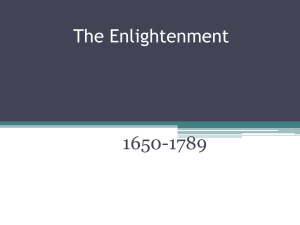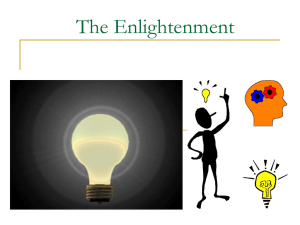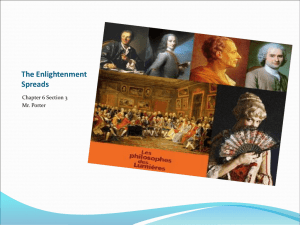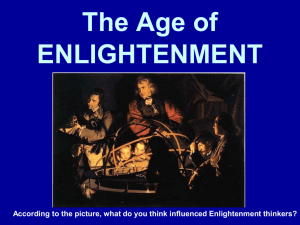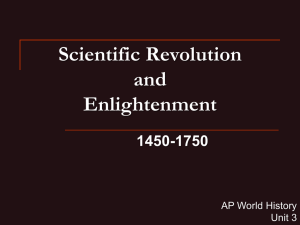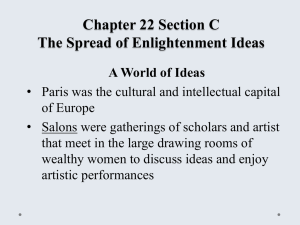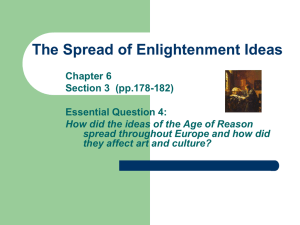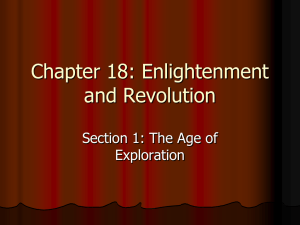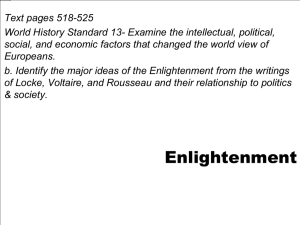History of Medicine Lecture 7
advertisement
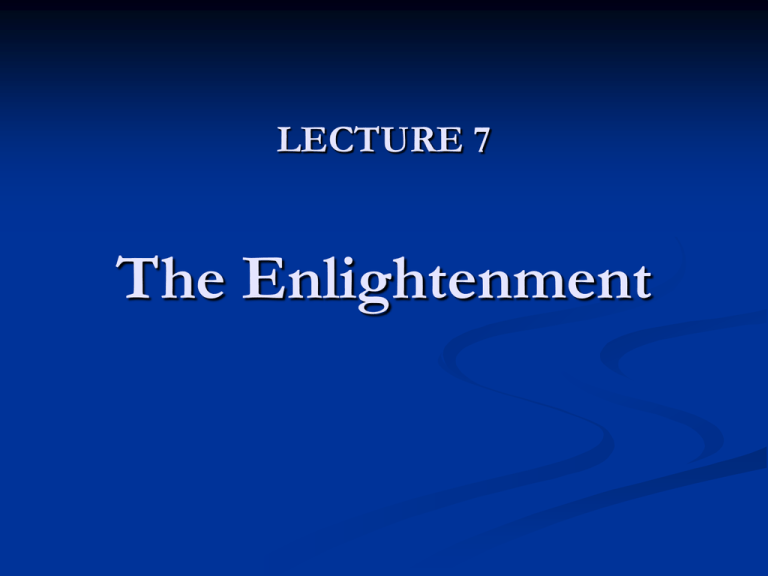
LECTURE 7 The Enlightenment The definition of Enlightenment Medical concepts of the Enlightenment The development of physiology The development of the internal medicine The development of surgery The Golden Age of Charlatanism The Enlightement The Age of Enlightenment or simply The Enlightenment is a term used to describe a time in Western philosophy and cultural life centered upon the eighteenth century, in which reason was advocated as the primary source for authority. The Enlightenment One of the medical theories that came into vogue during the early years of the century was that of: Georg Ernst Stahl (1660-1734). He rejected the view that the body was simply a machine and postulated instead the existence of an anima or sensitive soul that regulates the body health. Stahl was also a strong advocate of bloodletting. A colleague of Stahl’s at the University of Halle was: Friederich Hoffmann (1660-1742). According to his theory the entire body was composed of fibres which could dilate or contract in response to a property called tonus. This in turn was controlled by a nervous ether emanating from the brain. The Enlightenment William Cullen (1710-1790), professor at Glasgow and Edinburgh, was influenced by the theory of Hoffmann. Cullen’s theory of nervous energy as the determinant of the normal state of the body was further simplified by his pupil John Brown (1735-1788). He considered excitability to be the basis of bodily health. Because of this he recommended the use of stimulants or sedatives to assure the harmonious balance of stimuli. Theophile de Bordeu (1722-1776) proposed his own version. He considered that three important organs of the body: the stomach, heart and brain elaborated a secretion whose proper concentration in the blood stream helped to maintain health. He was the pioneer of endocrinology. The Enlightenment Hermann Boerhaave (1668-1738). Under the influence of Hermann, the University of Leyden became the leading medical school of all Europe. He placed the greatest emphasis on bedside instruction and also insisted that the student follow a patient’s body to the autopsy to fix clearly in mind the correlation between lesions and symptoms. Gerhard van Swieten (1700-1772), a pupil of Boerhaave was the personal physician of Empress Maria Theresa. He reorganized the teaching of medicine at the University of Vienna. Leopold Auenbrugger (1722-1809). He invented the diagnosis by percussion of the chest. He also showed how to plot the outlines of the heart and lungs by percussion. The Enlightenment He recognized diseased areas of lung, repeatedly confirming his options by postmortem examination. His book Inventum novum (1761) seems to be the first ever devoted entirely to diagnosis and the first to be based on an objective sign of disease. Alexander Monro (1697-1767) was a Scottish anatomist who studied under Boerhaave at Leyden. He returned to Edinburgh and brought its medical school into the front rank. Albrecht von Haller (1708-1777) was the most notable of all Boerhaave’s disciples. His many contributions to anatomy included a correct explanation of hernia. As a physiologist he demonstrated that while irritability was a property of muscles’ fiber, sensibility was a characteristic of the nerve fiber. The Enlightenment Rene de Reaumur (1683-1757) was the inventor of a thermometer Lazzaro Spallanzani (1729-1799) was a pioneer in experimental fertilization Stephen Hales (1677-1761) demonstrated the dynamics of blood circulation, stressing the importance of the capillary system and recording blood pressure with a manometer. Luigi Galvani (1737-1798) launched the new science of electrophysiology with his observation that nervous action in muscle could be included by an electrical charge. Giovanni Battista Morgagni (1682-1771) was professor of anatomy at Padua. His masterpiece On the Sites and Causes of Diseases (1761) contained descriptions of the five hundred cases which he saw at autopsy. The Enlightenment Xavier Bichat (1771-1802) studied over six hundred corpses and succeeded in identifying twenty-one different tissues. John Hunter a Scottish surgeon studied, taught and practiced in London. He was also regarded as the founder of scientific geology. His many contributions to medical science included the first account of inflamation. In operative surgery his great contribution was a new method of closing off an aneurysm. He also studied venereal diseases. In spite of the developments in chemistry, there were few therapeutic advances in the 18th century. Bleeding and purging persisted as the mainstays of the practitioner. Syphilis and other venereal diseases continued to be treated with massive doses of mercury. The Enlightenment CONCLUSIONS The most important drug introduced was digitalis, used to treat a wide variety of illnesses. In spite of the significant progress in medical science, this period was also called the Golden Age of charlatanism The figure of Franz Anton Mesmer (1734-1815) made his work on animal magnetism the major subject of debate. He thought hypnosis was a kind of celestial magnetism. During this period only the rich could be assured of the services of a qualified doctor of medicine. Johann Peter Frank (1745-1821), professor at Padua used statistics to establish the importance of public health. The Enlightenment Smallpox remained the single most deadly killer of the period Variolation had been used to prevent the dangerous attacks of smallpox. Edward Jenner (1749-1823) invented vaccination. His work was published in 1798. The 18th century was not only a period of consolidation and systematization, but also of considerable new discoveries.
